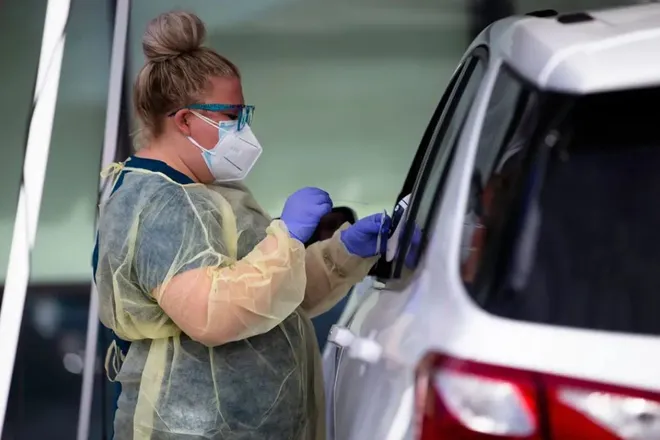 The good news is that Texas is finally seeing COVID-19 hospitalizations and cases trend downward after a holiday season marked by a record-breaking surge that pushed hospital systems and health care workers to their limits.
The good news is that Texas is finally seeing COVID-19 hospitalizations and cases trend downward after a holiday season marked by a record-breaking surge that pushed hospital systems and health care workers to their limits.
The bad news is that there are still more Texans getting sick and being hospitalized for the coronavirus than this summer, when the state was in the throes of the first wave.
And while vaccinations are reaching more people every day, health care experts warn that this doesn’t mean Texas is out of the woods. They say people should remain vigilant and continue following safety guidelines like mask-wearing and social distancing, especially as new variants of the virus continue to emerge. With Super Bowl Sunday around the corner, many are concerned about super spreader events that could undo the modest progress the state has experienced in the past few weeks.
Cases peaked in mid-January at an average of more than 22,000 per day. By Thursday, the average had decreased to around 16,500 per day. COVID-19 hospitalizations have also dipped from an all-time high of more than 14,000 patients on Jan. 12 to 10,523 reported patients on Thursday.
Texas is still experiencing more than 40% more daily cases on average than it saw during the previous summer peak for confirmed cases.
“The fact that things are decreasing, it doesn’t mean that we [get] to relax because every time we’ve done that, things go back really, really bad,” said Cesar Arias, a professor of infectious diseases at University of Texas Health Science Center at Houston.
Broadly, Texas health officials say the reason for the recent dip in numbers is because the state is coming off a spike related to gatherings from Thanksgiving and the December holiday season. But a combination of vaccines for health care workers and a decrease in large gatherings could also be contributing to the downward trends, said Philip Huang, director of health and human services in Dallas County.
Vaidehi Shah, Waco-McLennan County’s senior epidemiologist, added even before the pandemic began, January and February usually didn’t see as much travel — a trend that has helped lower positive case rates this year.
Still, more than 37,000 Texans have died, and there is still a long way back to normal, Arias said.
“Comparatively, we are nowhere near to where we should be, to be able to control this pandemic,” Arias said. “We’re getting to the peak of that exposure, and there’s probably much more people that are infected than we have been able to detect. So maybe it’s scratching the surface.”
Shah said she hopes hospitalization patterns in Waco will continue to improve at similar rates. By the beginning of January, COVID-19 patients were being treated in more than 30% of hospital beds in that region, a number that has since dropped in half.
During the pandemic, Shah said the trend has been a rise in cases, followed by a rise in hospitalizations, then a rise in deaths.
“And when the numbers go down, it goes in a similar pattern,” Shah said. “So [our region] did start seeing a reduction in cases about two to three weeks ago… We’re really hopeful we’ll see that same thing with fatality numbers as well.”
Medical professionals are also worried by the new COVID-19 mutations that have emerged in Texas and across the country over the past few months. The variants have the potential to be more contagious and could lead to another increase in case rates and hospitalizations down the line.
But Arias said he’s hopeful proliferation of the COVID-19 vaccines will help mitigate that spread. While the vaccine may be effective on new mutations as well, Arias said there are still factors that prevent vulnerable populations, like people of color, from receiving a dose in the first place.
“I don’t think we still have a very good plan to cover those at the moment,” Arias said. “Those are most likely where these situations are going to emerge in terms of the system viruses or mutated viruses that transmit better. So aggressive vaccination is really the only way out.”
Stephen Love, president of the Dallas-Fort Worth Hospital Council, said he’s worried about Super Bowl parties as another source of spread. Love said while people are often vigilant in settings like grocery stores, that level of caution tends to diminish at small gatherings.
“They get lax when they get home,” Love said. “I think a lot of the spread we’ve seen, especially during the holidays, and right after the holidays, didn’t occur out in public — it occurred in the home.”
Source: https://www.lubbockonline.com/story/news/2021/02/06/texas-covid-19-cases-down-record-highs-but-health-experts-warn-pandemic-far-over/4421702001/

